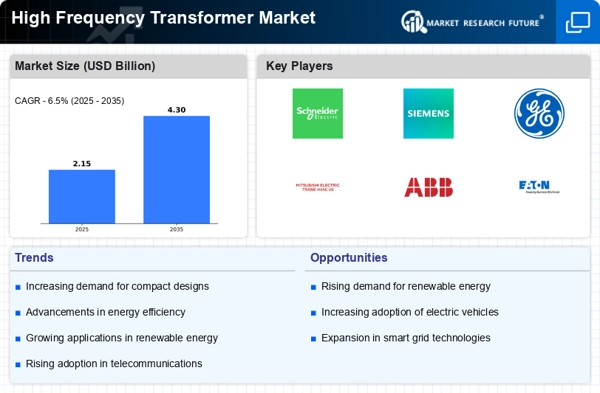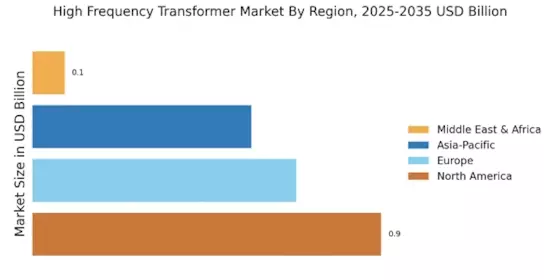Advancements in Telecommunications
The telecommunications sector is experiencing rapid advancements, which significantly impacts the High Frequency Transformer Market. With the rollout of 5G technology, there is a growing need for high frequency transformers to support the increased data transmission rates and improved signal quality. These transformers are integral to the functioning of base stations and other telecommunications equipment. Market data suggests that The High Frequency Transformer Market is projected to grow at a CAGR of approximately 6%, driven by the demand for faster and more reliable communication networks. This growth presents a substantial opportunity for the High Frequency Transformer Market to cater to the evolving needs of the telecommunications sector.
Growth in Electric Vehicle Infrastructure
The expansion of electric vehicle (EV) infrastructure is another key driver for the High Frequency Transformer Market. As the adoption of electric vehicles accelerates, the need for efficient charging solutions becomes paramount. High frequency transformers play a crucial role in EV charging stations, enabling faster and more efficient power delivery. The High Frequency Transformer Market is expected to witness a substantial increase, with projections indicating that EV sales could reach over 30 million units annually by 2030. This surge in demand for EVs necessitates the development of robust charging infrastructure, thereby creating a favorable environment for the High Frequency Transformer Market to thrive.
Emerging Applications in Medical Equipment
The High Frequency Transformer Market is also being propelled by emerging applications in medical equipment. High frequency transformers are increasingly utilized in medical devices, such as imaging systems and diagnostic equipment, where precise power management is critical. The healthcare sector is witnessing a surge in demand for advanced medical technologies, with The High Frequency Transformer Market projected to grow at a CAGR of approximately 5%. This growth is likely to create new opportunities for high frequency transformers, as they are essential for ensuring the reliability and efficiency of medical equipment, thereby enhancing the overall performance of the High Frequency Transformer Market.
Rising Demand for Renewable Energy Solutions
The increasing emphasis on renewable energy sources is driving the High Frequency Transformer Market. As countries strive to meet energy efficiency targets, the integration of high frequency transformers in renewable energy systems, such as solar inverters and wind turbines, becomes essential. These transformers facilitate efficient energy conversion and transmission, thereby enhancing the overall performance of renewable energy systems. According to recent data, the renewable energy sector is projected to grow at a compound annual growth rate of over 8% in the coming years, which is likely to bolster the demand for high frequency transformers. This trend indicates a significant opportunity for manufacturers and suppliers within the High Frequency Transformer Market.
Increased Investment in Industrial Automation
The trend towards industrial automation is significantly influencing the High Frequency Transformer Market. As industries seek to enhance productivity and efficiency, the adoption of automated systems and machinery is on the rise. High frequency transformers are essential components in various industrial applications, including robotics and automated manufacturing processes. Recent statistics indicate that the industrial automation market is expected to grow at a CAGR of around 9% over the next few years. This growth is likely to drive the demand for high frequency transformers, as they are crucial for ensuring reliable power supply and performance in automated systems, thereby benefiting the High Frequency Transformer Market.


















Leave a Comment